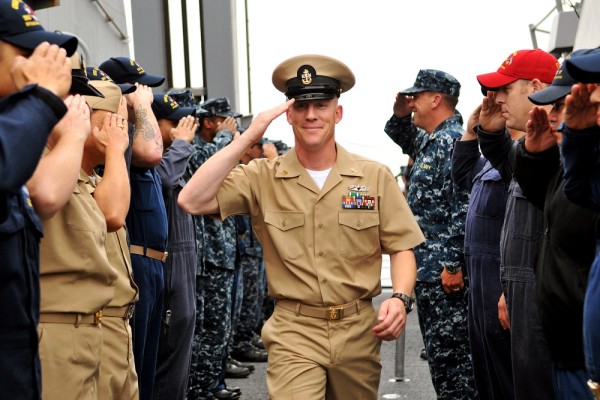

The U.S. military has been an all-volunteer force now for over 40 years. Despite some misgivings, everything has turned out pretty well. Our services are better manned, trained, and equipped than ever before. The military is barely recognizable compared to the force that deployed to Vietnam in the 1960s and early 1970s: Its speed, ferocity, and dominance are unmatched.
Despite significant changes in almost every aspect of the defense department, however, a lot of outdated practices remain. The worst offender is the distinction between enlisted and commissioned personnel. The Pentagon should get rid of the archaic system in favor of something that reflects the modern military’s capabilities and responsibilities.
There are plenty of ways to rationalize the system, which we inherited from the British as a colony. You can think of it as officers are responsible for “leadership and administration” while enlisted do the grunt work. You can use a sports analogy, calling officers “coaches” and enlisted “players”. Quora superuser, and former enlisted Marine, Jon Davis offers a good summary of the current command structure: “[O]ne is focused on a job (the enlisted) and the troops capabilities to do it, while the other is focused on command and deployment of those troops (officers).”
Whatever the explanation, they all break down on closer inspection. The difference between the two groups is imaginary, a convenient system that we keep using because it’s easier than trying to reorganize in a more effective way. The reality is that officers used to come almost exclusively from the nobility — who were thought to be intrinsically superior — and everyone else had to enlist.
That’s bullshit. A combination of aptitude, desire, dedication, training, and experience that can turn just about anyone into a good leader, coach, manager — whatever you want to call the people in charge.
As a 21-year-old Marine corporal, I was responsible for a plussed-up fire team of Marines, totaling six people besides myself. Many of my buddies had similar roles and responsibilities at about the same age, and some shouldered much greater burdens. There are plenty of junior officers who are never directly responsible for that many people, especially outside the combat arms community.
The military currently organizes, trains, and equips its personnel based on the assumption that everyone — save a select few — is a conscripted idiot who needs constant supervision. While there are certainly people like that serving in uniform, it doesn’t make sense to run an organization based on the lowest common denominator. Even worse, the disparities in rank can become a self-fulfilling prophecy, as myths about officers and enlisted permeate the business world.
One of the worst problems in the system is the number of people who should volunteer to serve in the military but do not because they only want to be officers. These special snowflakes apply to service academies in droves. They would likely benefit as leaders from starting out at a different level and progressing through the (undivided) ranks.
We would also get a lot more high-quality recruits. The five service academies are among the most selective education institutions in the country, turning away tens of thousands of qualified, motivated people at a cyclic rate. Some of these students do ROTC elsewhere, but what about the ones who shrug their shoulders and move on? If everyone started at square one, things would look different. We could allow these folks to join like everyone else then get sorted, trained, and placed according to actual performance.
I’m not the first person to think about this. Even civilians are confused about the way the military plods along this organizational path. It’s time to consider whether the military should do more than just tinker around the edges with its personnel structures and policies. Maybe we need stop pre-sorting people and look instead at how people perform once they’re in the military.
CORRECTION: An earlier version of this article incorrectly referred to four service academies, not five. (6/4/2015; 2:18 pm)